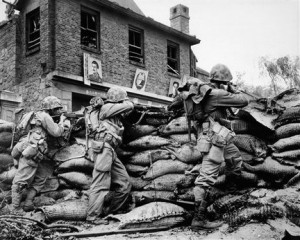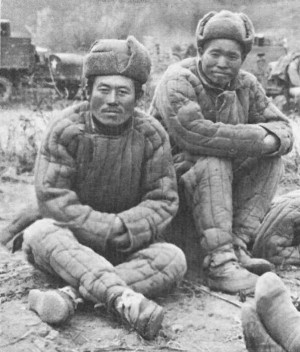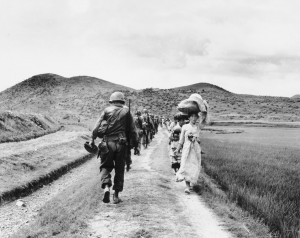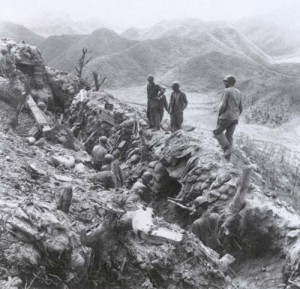With the Korean peninsula teetering ever closer towards the breakout of war, it seems only fitting that we dedicate one of our fine lists to reflect back on the circumstances which have caused one of the most unique cultural, social and political divides in the modern world. Having been occupied as a colony by the Empire of Japan from 1910 to the end of the Second World War, Korea was divided upon Japans surrender to the Allied command. Much like Germany, the division erupted as a result of equal US and Soviet interest, as well as an unwillingness to back down. While the territory north of the ‘38th Parallel’ was taken on by the Communist USSR, the south of the country remained under the occupation of US troops. Obviously, conflict broke out on the peninsula as the Cold War ushered in- with the communist north invading the capitalist south. The Korean War raged on for several years, and prompted a series of interesting occurrences in the process. Let us take a look at ten of the conflicts most notable milestones.
10. The Division of Korea

In many ways the opening sequence of a drama which continues at full heat to this day, the initial division of the Korean nation following the conclusion of World War Two set into motion a whole series of events which inevitably led to the war. The initial intentions of the US and USSR following the wars end was to temporarily occupy the nation as a united trusteeship until a national provisional government could find its feet and take charge. While an admirable course of action, it failed to materialise when the Soviets refused to cooperate with United Nations when the time for an election arose. Instead, the USSR set about establishing the north as a communist state, and claimed sovereignty over the entire nation. With the south of the country more inclined towards a western political structure by this time, the stand-off began. The border between each sector, established along the 38th parallel circle of latitude, soon became heavily militarised.
9. The US Show Weakness

Given the heightening rivalry between the US and Soviet Russia, who were un-arguably the two largest superpowers of the time, it was imperative for both sides to dig their heels in over matters such as Korea. While neither nation may have had a serious interest in maintaining their position on the peninsula, the last thing either side wanted was to portray themselves as weak. By the start of 1950, the Cold War was in full swing, with both sides probing for bluffs in the others hard-shelled exterior. In January 1950, United States Secretary of State Dean Acheson claimed that the defence of southern Korea was a matter related solely to the recently established UN, and the US would not be held responsible for any matters of unrest there. In the eyes of the Soviets, this was a chequered flag.
8. Stalin and Mao Give Their Blessing

Though five years had passed since the end of the Japanese occupation, Soviet leader Josef Stalin was still intrinsic to the governmental structure of North Korea. Having sought to establish the new-found nation as a fellow communist state, a friendship with the USSR had naturally been established. North Koreas leader Kim Il-sung took much confidence from this fact, and as a result spent the first half of 1950 travelling to both Moscow and Beijing in search of support for a proposed invasion of the south. Whilst the amount of support eventually granted to Il-sung from both the USSR and China remains a commonly debated point, it was certainly enough for the North Korean leader when combined. A North Korean force entered the south on June 25th, 1950.
7. North Reach Pusan

At first, the North Korean Army (NKA) was extremely successful in their invasion, driving the joint South Korean/American force all the way down to Pusan (a small province in Koreas southwest) within just 4 months. By September 1950, the communists dominated all but 10% of South Korea. A combination of the invasions unexpectedness, the overwhelming size and might of the NKA as well as the ill-practiced state of the US troops present in the south is widely credited as the reason for this initial ass-kicking.
6. General MacArthur Takes Over

Following the lighting fast progress of the NKA, the Allied (US, SK, UK) forces in the south were forced into heated combat. Though their position in Pusan was somewhat secure, with a concentrated military force supplement by the natural defences supplied by the Nakdong river- high command knew that something had to be done fast if the communists were to be held at bay for any lengthy amount of time, let alone pushed back northwards. US General MacArthur in turn devised a plan to land a force amphibiously at Inchon, in an attempt to pincer the NKA between two Allied forces, as well as to cut them off from their home in the North. Kim Il-sung was tipped off about the plan, named ‘Operation Chromite’, though failed to devote any worry to it on account of it being far too risky, which it undoubtedly was. Regardless, Operation Chromite was a success and the North’s forces found their supply lines completely severed.
5. North Flees North

With the landings at Incheon, the North’s forces realised that they could potentially be cut off from home if they waited around any longer. As a result, they marched north pretty much immediately, chased the entire way by the South, and crossed the 38th Parallel. In typical style, the avenging forces of the South/US/UN were far from content with having chased the communists all the way home, and tittered on an advance into foreign territory for the first time since the wars beginning. General MacArthur argued for an invasion of the North, on the grounds that they wipe out communism there for once and for all. It didn’t take long for approval to come through, and just as the north had invaded the south, the south invaded the north.
4. Mao Gets Nervous

Though the Chinese, under rule of the now infamous Chairman Mao, had supplied counsel to the north in the months leading up to their invasion of the south, no Chinese troops had yet been involved in any fighting. Soon after the Allied advance into North Korea however, this was set to change. Much of the initial fighting on the north side of the 38th Parallel took place within extremely close proximity to the Chinese border. This of course made Mao nervous, and soon Il-sung was able to convince his fellow communist leader to enter the conflict.
3. China Enters

Like most of the other events which constituted this conflict, the entrance of Chinese troops did not take long at all. With continued fighting raging on in North Western Korea just miles from the Chinese border, Mao decided not to wait long at all before dispatching forces to aid the Northern communists. Kim Il-sung was of course delighted with this decision, while I imagine the feelings of MacArthur and co to be quite the opposite. By the November of 1950, Chinese and American/southern troops were engaging with one another.
2. North Head South Again

With a new found confidence, which would presumably be felt by any army who had just enlisted the help of the Chinese, the NKA was once again primed and ready to head south- Il-sung clearly still set on his mission of total sovereignty over the peninsula. The southern Allied force once again found itself on the back-foot, and with the full weight of early 1950’s communism pressing down on them, retreated back over onto their side of the 38th Parallel. The northern/Chinese force made good ground in the opening months of 1951, however ground to a halt long before reaching as far south as Pusan.
1. Stalemate and Ceasefire

Being that the conflict was such a fast paced one, both sides soon found themselves entirely exhausted and maybe even somewhat disillusioned by the war. The prime result of such symptoms of warfare was in this case colossal stalemate, the likes of which hadn’t been seen since the First World War some 30 or 40 years before. While the war had begun as one of frantic territorial change and vast open grounded advances, it soon became bogged down and dominated by trenches and their undying monotony. Though there were some notable cases of territory changing hands once or twice, both sides became tired of their comparatively fruitless pursuit and a ceasefire was eventually agreed in the July of 1953. The ceasefire remains in place to this day, and no peace treaty has yet been drafted between the communist north and the westernised south.